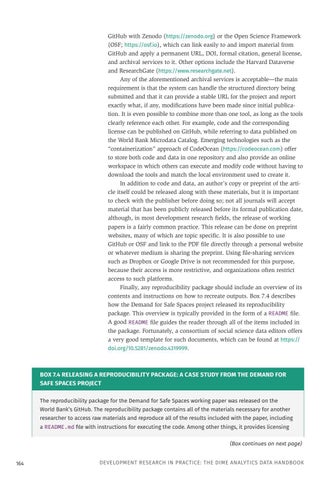GitHub with Zenodo (https://zenodo.org) or the Open Science Framework (OSF; https://osf.io), which can link easily to and import material from GitHub and apply a permanent URL, DOI, formal citation, general license, and archival services to it. Other options include the Harvard Dataverse and ResearchGate (https://www.researchgate.net). Any of the aforementioned archival services is acceptable—the main requirement is that the system can handle the structured directory being submitted and that it can provide a stable URL for the project and report exactly what, if any, modifications have been made since initial publication. It is even possible to combine more than one tool, as long as the tools clearly reference each other. For example, code and the corresponding license can be published on GitHub, while referring to data published on the World Bank Microdata Catalog. Emerging technologies such as the “containerization” approach of CodeOcean (https://codeocean.com) offer to store both code and data in one repository and also provide an online workspace in which others can execute and modify code without having to download the tools and match the local environment used to create it. In addition to code and data, an author’s copy or preprint of the article itself could be released along with these materials, but it is important to check with the publisher before doing so; not all journals will accept material that has been publicly released before its formal publication date, although, in most development research fields, the release of working papers is a fairly common practice. This release can be done on preprint websites, many of which are topic specific. It is also possible to use GitHub or OSF and link to the PDF file directly through a personal website or whatever medium is sharing the preprint. Using file-sharing services such as Dropbox or Google Drive is not recommended for this purpose, because their access is more restrictive, and organizations often restrict access to such platforms. Finally, any reproducibility package should include an overview of its contents and instructions on how to recreate outputs. Box 7.4 describes how the Demand for Safe Spaces project released its reproducibility package. This overview is typically provided in the form of a README file. A good README file guides the reader through all of the items included in the package. Fortunately, a consortium of social science data editors offers a very good template for such documents, which can be found at https:// doi.org/10.5281/zenodo.4319999.
BOX 7.4 RELEASING A REPRODUCIBILITY PACKAGE: A CASE STUDY FROM THE DEMAND FOR SAFE SPACES PROJECT The reproducibility package for the Demand for Safe Spaces working paper was released on the World Bank’s GitHub. The reproducibility package contains all of the materials necessary for another researcher to access raw materials and reproduce all of the results included with the paper, including a README.md file with instructions for executing the code. Among other things, it provides licensing (Box continues on next page) 164
DEVELOPMENT RESEARCH IN PRACTICE: THE DIME ANALYTICS DATA HANDBOOK





